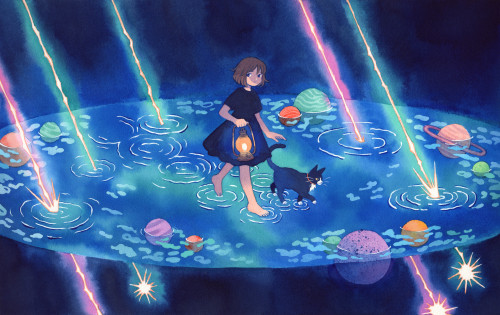This Is The Eskimo Nebula! ⛄⛄⛄

This is the Eskimo Nebula! ⛄⛄⛄
This nebula is created by the death of a Sun-like star and its strange 2 layered appearance gives it a lot of creative names such as the Clown-Faced Nebula or the Lion Nebula. Even though it looks like the planetary nebula is smooth, the reality is that it has dense filaments of matter all around it! ✨✨✨
Taken by me (Michelle Park) using the Slooh Chile One telescope on December 6th, 2020 at 3:58 UTC.
More Posts from Mystarypi and Others

Moocha, Srawberry, Vanilla 🐮

This is the Tarantula Nebula! 🌈🌈🌈
For some reason, this photo really highlighted the red and blue colors of this nebula - making it look a lot more colorful. This huge star-forming region is located in our satellite galaxy, the Large Magellanic Cloud, and has hot gas up to a million degrees in temperature that shape this nebula! ✨✨✨
Taken by me (Michelle Park) using the Slooh Canary Two telescope on December 23rd, 2020 at 2:57 UTC.


🌸 my first time bullet journaling! This was done a while ago! Also this is my first post on tumblr💕 🌸
IG: @_akadanie

Unknown Orbit🪐💫 A painting for my first solo exhibition ’Out of this World’ at Gallery Nucleus in November! I hope you like it, I really enjoyed painting this💕✨

This is the Orion Nebula! ✨✨✨
Thought to be a cosmic fire of creation by the Mayans, the Orion Nebula’s bright, vibrant colors come from the massive stars in the open star cluster at the center of the nebula. This star forming region is giving birth to thousands of stars, each of them only a few million years old! 💫💫💫
Taken by me (Michelle Park) using the Slooh Canary Two telescope on March 21st, 2021 at 22:53 UTC.

Lagoon Nebula, M8, in Sagittarius ❤
Taken by me (Michelle Park) using the Slooh Canary Two Telescope, taken in August 2018.

This is Comet PanSTARRS! 🌠🌠🌠
This gif was created throughout the night of July 25th and you can see the potentially interstellar comet in motion.
Taken by me (Michelle Park) using the Slooh Canary One telescope on July 25th, 2022.

This is the Statue of Liberty Nebula! 🗽🗽🗽 (I guess to celebrate the inauguration!)
The dramatic shapes of the nebula are created by young, hot stars that were newly formed through this nebula. Most of the star formation takes place in the dark filaments in this region and it is located just a few thousand light years away from the famous Eta Carinae Nebula (also a prolific star forming region)! ✨✨✨
Taken by me (Michelle Park) using the Slooh Chile Two telescope on January 18th, 2021 at 5:12 UTC.

This is the Lunar Eclipse of May 15th, 2022! 💖💖💖
As the Earth’s shadow covers the Moon, it appears to disappear into darkness. This is just one of 85 lunar eclipses that will occur in the 21st century. If you missed this one, don’t worry! The next total lunar eclipse will occur on November 8th, 2022. 🌑🌛✨
Taken by me (Michelle Park) using the Slooh Canary One telescope on May 15th, 2022.

This is the Pelican Nebula! 🦢🦢🦢
The molecular cloud of dark dust on the left of this image separates this nebula from the nearby North America Nebula. This nebula is quickly changing as newborn, hot stars ionize the gas and push it around, leading to its expansion! 💖💖💖
Taken by me (Michelle Park) using the Slooh Canary Two telescope on August 9th, 2021 at 3:52 UTC.
-
 silvereyedowl reblogged this · 9 months ago
silvereyedowl reblogged this · 9 months ago -
 xploseof reblogged this · 10 months ago
xploseof reblogged this · 10 months ago -
 emotionalmoonbot reblogged this · 1 year ago
emotionalmoonbot reblogged this · 1 year ago -
 acarelesskid23 liked this · 1 year ago
acarelesskid23 liked this · 1 year ago -
 xploseof liked this · 1 year ago
xploseof liked this · 1 year ago -
 silvereyedowl liked this · 1 year ago
silvereyedowl liked this · 1 year ago -
 ask-de-writer liked this · 1 year ago
ask-de-writer liked this · 1 year ago -
 charleybee liked this · 1 year ago
charleybee liked this · 1 year ago -
 krufflplump liked this · 1 year ago
krufflplump liked this · 1 year ago -
 grouchycloud liked this · 1 year ago
grouchycloud liked this · 1 year ago -
 meowmiaomiau liked this · 1 year ago
meowmiaomiau liked this · 1 year ago -
 kotaishere liked this · 1 year ago
kotaishere liked this · 1 year ago -
 siderealtime reblogged this · 1 year ago
siderealtime reblogged this · 1 year ago -
 siderealtime liked this · 1 year ago
siderealtime liked this · 1 year ago -
 littleblackcloud1980 liked this · 1 year ago
littleblackcloud1980 liked this · 1 year ago -
 notthisvirgin liked this · 1 year ago
notthisvirgin liked this · 1 year ago -
 lady-d-ac reblogged this · 1 year ago
lady-d-ac reblogged this · 1 year ago -
 lady-d-ac liked this · 1 year ago
lady-d-ac liked this · 1 year ago -
 armameery reblogged this · 1 year ago
armameery reblogged this · 1 year ago -
 armameery liked this · 1 year ago
armameery liked this · 1 year ago -
 that-one-queer-poc liked this · 1 year ago
that-one-queer-poc liked this · 1 year ago -
 nightwing1221 liked this · 1 year ago
nightwing1221 liked this · 1 year ago -
 ronaldsprowel liked this · 1 year ago
ronaldsprowel liked this · 1 year ago -
 tophlovesbeer liked this · 1 year ago
tophlovesbeer liked this · 1 year ago -
 fuckyeahcelestialthings reblogged this · 1 year ago
fuckyeahcelestialthings reblogged this · 1 year ago -
 infamousrunawayxnginxxr liked this · 3 years ago
infamousrunawayxnginxxr liked this · 3 years ago -
 we-chase-the-stars reblogged this · 4 years ago
we-chase-the-stars reblogged this · 4 years ago -
 generalturkeymakerfestival-blog liked this · 4 years ago
generalturkeymakerfestival-blog liked this · 4 years ago -
 etherealherisis liked this · 4 years ago
etherealherisis liked this · 4 years ago -
 rory-32 liked this · 4 years ago
rory-32 liked this · 4 years ago -
 nesfarsit liked this · 4 years ago
nesfarsit liked this · 4 years ago -
 reiki-master-lia-blog liked this · 4 years ago
reiki-master-lia-blog liked this · 4 years ago -
 nekromonaeditsiguess liked this · 4 years ago
nekromonaeditsiguess liked this · 4 years ago -
 plebastronomy liked this · 4 years ago
plebastronomy liked this · 4 years ago -
 mailingstarman liked this · 4 years ago
mailingstarman liked this · 4 years ago -
 elekronialazure liked this · 4 years ago
elekronialazure liked this · 4 years ago -
 bohemotash liked this · 4 years ago
bohemotash liked this · 4 years ago -
 getas-regina reblogged this · 4 years ago
getas-regina reblogged this · 4 years ago -
 purple-rosa liked this · 4 years ago
purple-rosa liked this · 4 years ago -
 insightsyouneveraskedfor liked this · 4 years ago
insightsyouneveraskedfor liked this · 4 years ago -
 bydas liked this · 4 years ago
bydas liked this · 4 years ago -
 bydas reblogged this · 4 years ago
bydas reblogged this · 4 years ago -
 jmmjk22 liked this · 4 years ago
jmmjk22 liked this · 4 years ago -
 kyle-stranger liked this · 4 years ago
kyle-stranger liked this · 4 years ago -
 various-aestheticss liked this · 4 years ago
various-aestheticss liked this · 4 years ago
